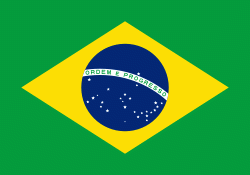São Caetano do Sul (São Caetano do Sul)
 |
 |
It is intensely conurbated with São Paulo, Santo André and São Bernardo do Campo, causing the physical limits between cities to be lost. São Caetano do Sul, together with Ferraz de Vasconcelos, is one of two cities in the state of São Paulo that are not crossed by any state or federal highway.
The region in which the municipality of São Caetano do Sul is today is occupied since the 16th century when it was known as Tijucuçu. It was an area of estates of residents of the former settlement, later villa (1553), of Santo André da Borda do Campo, extinguished by order of the governor-general Mem de Sá.
In the seventeenth century a group of Benedictine monks formed in the region, donated by a farmer, the Monastery of Saint Benedict and the Tijucuçu Farm, used by the monks to raise cattle. In 1717, the monks began to erect the chapel dedicated to Saint Cajetan di Thiène (In Portuguese, São Caetano), the patron saint of bread and work, in the place where the Old Matrix of St. Caetano is today. They passed the farm to be called Farm of São Caetano do Tijucuçu, then São Caetano Farm. Around the farm was developed the district of São Caetano, in the same territory of the city of São Paulo. It was first enumerated in 1765, when the Morgado de Mateus determined that a census of the population of the Captaincy of São Paulo was made. Its inhabitants were farmers and tropeiros and they received the sacraments in the Chapel of São Caetano.
In 1871, on the day after the Free Womb Law, the Order of Saint Benedict decided, in its General Chapter of Bahia, to free all of its slaves, in Brazil, more than four thousand, without any compensation. Deprived of labor, Farm São Caetano was expropriated by the Imperial Government to install the Colonial Nucleus of São Caetano on 28 July 1877. The lands of the farm were divided into lots and sold to Italian settlers between 1877 and 1892, when the last family of immigrants entered the Nucleus. The first group of families settled in the nucleus had embarked in the port of Genoa and arrived in Brazil on the Italian ship Europa. All the families were from the commune of Cappella Maggiore and its surroundings, in the province of Treviso, in the region of Veneto, northern Italy.
In 1883 the São Paulo Railway inaugurated the station of São Caetano and in 1889 the government of the province reformed the Way of the Sea and the Old Way of Santo André da Borda do Campo, that from 16th century crossed the region, the tributary of the railway.
Shortly before the Republican coup d'état was created the municipality of São Bernardo, dismembered of the one of São Paulo, and the greater part of the Colonial Nucleus and of the old district of São Caetano was attached to it.
In 1905, São Caetano was elevated to Fiscal District. In 1924 the village became a city. In 1947, in a movement led by the Jornal de São Caetano, a list of 5,197 signatures was made and sent to the State Legislative Assembly, requesting a plebiscite. The popular consultation was held on 24 October 1948; 8,463 people voted in favor of autonomy, and 1,020 voted against. On 24 December 1948, the governor of the state of São Paulo, Ademar de Barros, ratified the decision and created the "municipality of São Caetano do Sul", through State Law n. 233, dated 12/24/1948, adding the qualifier of the South, to distinguish it from Pernambuco's homonym. On 30 December 1953, the County of São Caetano do Sul was created
Map - São Caetano do Sul (São Caetano do Sul)
Map
Country - Brazil
Currency / Language
| ISO | Currency | Symbol | Significant figures |
|---|---|---|---|
| BRL | Brazilian real | R$ | 2 |
| ISO | Language |
|---|---|
| EN | English language |
| FR | French language |
| PT | Portuguese language |
| ES | Spanish language |


















